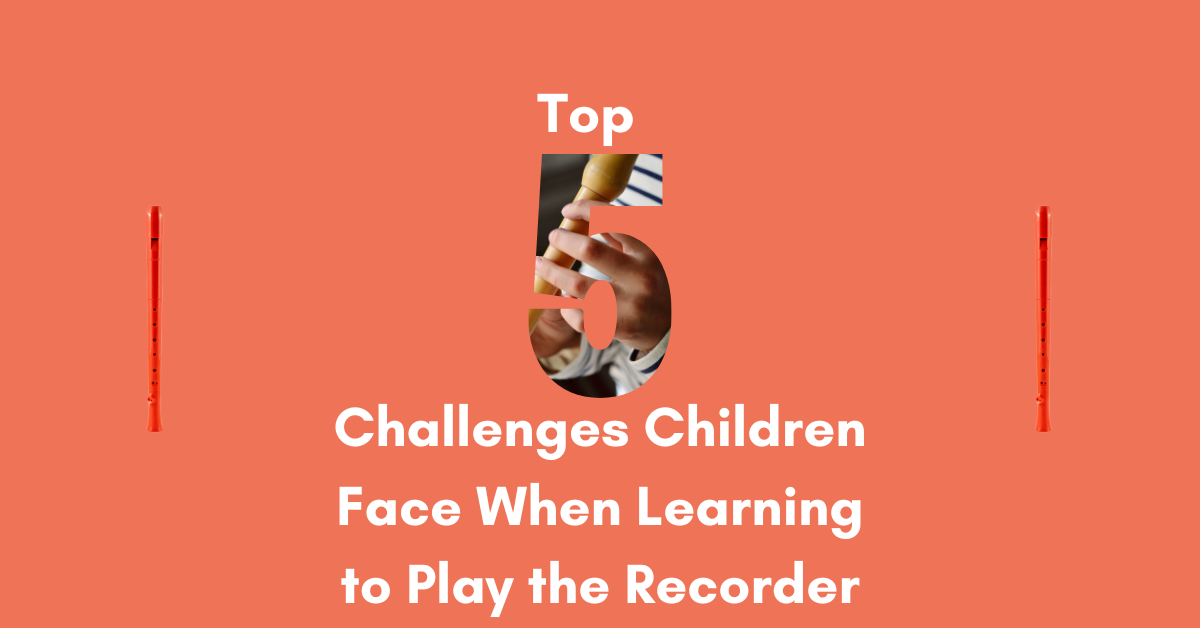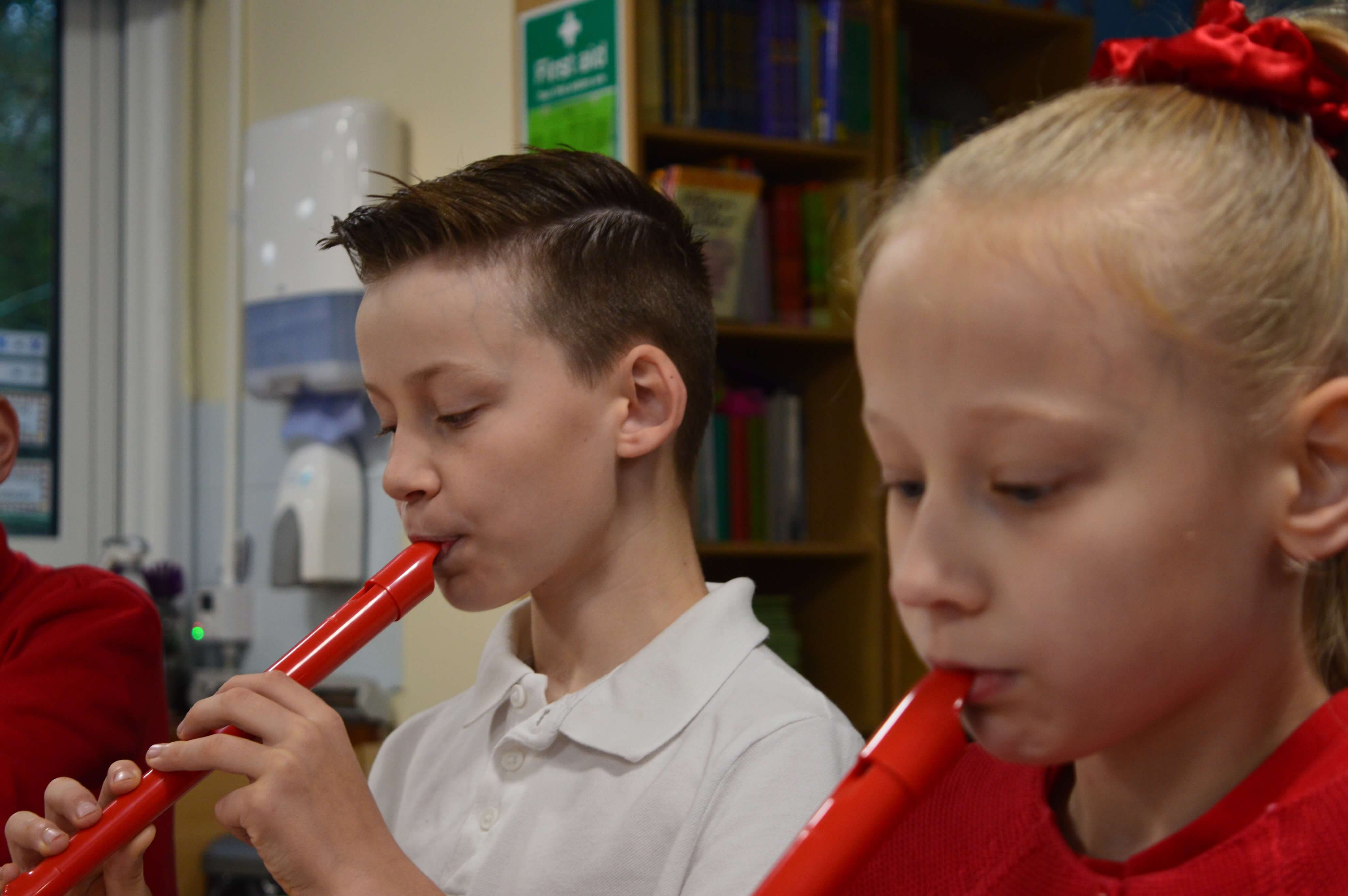Top Five Challenges Children Face When Learning to Play the Recorder
June 26th, 2023
5 min read

The squeak. The squeal. The piercing, shrill sound turns you into a nervous wreck.
Is it a supernatural being? Is it terror in its purest form? Is it the broken car alarm next door that always seems to start at the exact moment that you pour your first coffee of the day?
No. It's those first notes your child plays on a recorder.
Whether it's an early stab at 'Twinkle twinkle little star' or a version of 'Baby Shark' that is somehow more unbearable than the original track, those first sounds from an instrument do not make for easy listening.
As with any musical instrument, learning to play the recorder has its challenges. If you are musical, you may feel like you can offer advice and guidance. But for many parents without the experience of playing an instrument, there is uncertainty about how best to support their child with their learning. After all, those squeaks and squeals just might turn into something smoother and sweeter over time. But how do they get there?
The Warwick Music team have seen this journey firsthand: through our own learning, teaching others, and watching our children learn to play instruments. We understand that it can be a bumpy ride, which is why we design our instruments to be easy and accessible for children who are starting out.
We've pulled together five common problems your child could face when learning to play the recorder and some simple solutions. Whatever your level of musical expertise, we'll share our insider info on getting the best from your child's exciting new musical adventure.

1. Conquering the squeaks and squeals when learning to play the recorder
The recorder is the choice for many beginner musicians because of its simple design and fingering. There are lots of other reasons for choosing to play the recorder: it is lightweight, easy to maintain, and is often taught in large groups in the classroom. But producing those first notes and focusing on breathing can still make things difficult early on. Squeaks and squeals are an occupational hazard with learning to play the recorder, but here are some tips that you can offer your little learner:
- Encourage proper breath control and steady airflow. This is a crucial part of learning to play any woodwind instrument and can be practised without a recorder. It might even encourage some mindfulness moments!
- Practice with simple tunes. There is a reason that nursery rhymes and kids' songs are a great fit for learners: they help children to learn the basics. It may require some patient listening, but gradually your child will progress to more complex songs. You might even be able to make requests!
- Offer positive reinforcement. Like any learning activity, boosting your child's confidence will accelerate their progress. That crayon portrait you posted up on the fridge? Think of these first exploratory sounds as those first scrawls and scribbles. With time, the picture will become clearer.
2. How to help with finger dexterity in recorder playing
The fingering system in a recorder might be simpler than some other musical instruments, but that doesn't make it easy. Coordinating finger movements can be tricky for young children, as each note requires precise placement of fingers over the recorder's finger holes. Along with breathing and posture, accurate finger placement will lead to smoother, silkier sounds (we promise). Here are some tips to help:
- Start with scales. Finger exercises, such as scales or simple patterns, will improve coordination. Focusing on these building blocks of music will help your child's dexterity and build their confidence in their playing.
- Break down songs into smaller sections. Like lots of other learning activities, breaking a task into bitesize chunks can take away the pressure. Encourage your child to go step by step with the lines from a song, before combining them together. Those shrill sounds will be a thing of the past!
- Use finger charts. Making the most of fingering charts will help your child to become familiar with placements on the recorder. They are also a great reference for non-musicians: even if you don't know how to play the recorder, you have a visual guide to troubleshoot!
If some of these ideas sound tricky for non-musicians, there are stacks of excellent, free recorder resources available online. Recordists such as Sarah Jeffrey even have courses available on YouTube to help your child learn to play the recorder:
3. Teaching beat and rhythm with the recorder
Tempo is another challenge that children must overcome when learning to play the recorder. Luckily, it's another area that non-musicians can offer guidance. With simple exercises, you can help your child to stay on the beat. Here are a few strategies to tame the tempo:
- Use a metronome or backing track. You can use a free online metronome or a traditional model to provide a steady beat during practice sessions. Start slowly and gradually take the number higher. The numbers refer to BPM (Beats Per Minute), so 60 BPM is a ticking clock, and 120 BPM is twice as fast.
- Clap and tap rhythms. Clapping and tapping exercises will teach your child the basics of rhythm and can even begin to introduce more complex ideas for reading music. There are lots of clapping exercise videos that you can try if you are struggling with ideas, but picking a song that they know and clapping the beat is a great start!
- Play along with songs. As with breathing, playing along with familiar songs will help children to understand the tempo. Try it with songs where they are confident in their breathing and fingering and keep trying until they are in the groove!
4. How to overcome intonation Issues with the recorder
Intonation or pitch is a major hurdle for beginner recorder players. Young players may struggle for consistency with hitting the right notes, but this is common for all beginner musicians. Pitch is how high or low the note is and when those notes aren't right, it can be frustrating (for players and their patient parents listening on!) Here's how you can help your child to overcome intonation issues:
- Try ear training exercises. Pitch is not all about playing: listening and hearing the different notes will help your child to understand pitch. Singing or playing along to songs that they know is a fun way to encourage their pitch progress!
- Use a tuner or a keyboard. If you have had music lessons as a child, you might remember being taught by a piano or keyboard. We can use the notes from a keyboard, or a tuner, to give a reference point for the notes on a recorder. Even if you are not musical, you can pick out one key that corresponds to the note your child is making. What does it sound like? Does it sound the same? How does it make them feel? Can they make that note again?
- Try alternate fingerings. If your child is still struggling, speak to their recorder teacher. It may be that the fingering they are using does not suit them, but other options may be available. Some budget recorders may have poor intonation, so check that their instrument is not the problem.
5. Motivating your child when learning to play the recorder
This might seem like an obvious point. After all, you want your child to succeed and strive for greatness. But learning to play any instrument requires lots of dedication and perseverance. It can be frustrating, it can be stressful, and this can lead to your child losing motivation. When these issues set in, the support of a parent can make all the difference, so here are some tips to keep your mini music-maker engaged:
- Stay realistic. Starting out is hard, so it can be tempting to push your child and get over those initial barriers as quickly as possible (if only to save yourself a fortune on earplugs). But regular, realistic practice is far more beneficial in the long term. Encourage some structure but take the pressure off and the music will follow.
- Take lots of regular breaks. Learning to play the recorder is fun! If your child is feeling burnt out and over-practising, that fun will quickly evaporate and the motivation to continue will vanish. Slow and steady wins the race!
- Allow them to follow their own learning path. You might be tired of the Encanto soundtrack or worried that Shotgun by George Ezra has burrowed so deep into your brain that it will never leave. If these are the songs that your child is motivated by, allow them to explore. And if they are struggling to stay engaged with the learning process, dig out new songs and genres for them to try.

Learning to play the recorder is exciting. It is engaging, rewarding, and can even be life-changing! Part of any learning journey is overcoming challenges, working through the kinks, and feeling a sense of achievement when everything comes together harmoniously. Whether you have embarked on your own past musical journey or are learning along with your child for the first time, staying motivated and being a part of their discovery is everything. Who knows where that journey will take them?
- Sticking with your child every step of the way will reap all the benefits that learning a musical instrument can bring. Discover all of the benefits of music.
- You can also learn about the top ten benefits of music for young children in this article.
- Learn more about pCorder, the world's first carbon-neutral, recyclable, and anti-microbial recorder.
Adam is the Content Manager at pBone Music. This should mean that he’s the ideal person to write about himself, but he finds boasting in the third person a little awkward. He honed his word wizardry with a degree in English Language and Literature at the University of Leeds. He has since written copy for clients and businesses across the land, from awards to something beginning with “z”. He also spent a number of years as a musician. He has written pop songs and even jingles for kids, performed more first dances at weddings than you could shake a pBuzz at, and once played a gig for a pie company at The Etihad Stadium in Manchester. When he’s not reminiscing about those good old days, you might find Adam enjoying the football (although as an Everton fan, that can be difficult). He also loves spending time with his partner, Jen, and his family and friends, and sincerely hopes they feel the same way.
